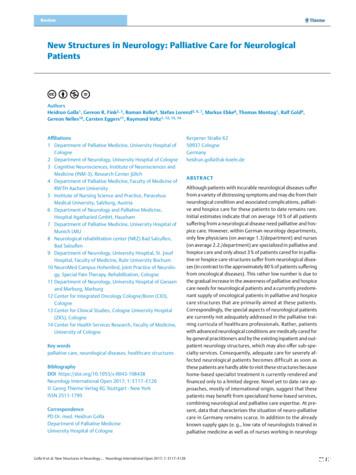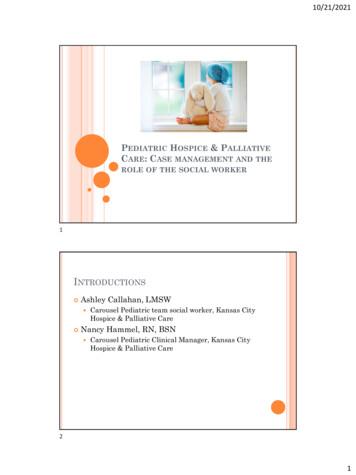Understanding Hospice And Palliative Care
Understanding Hospice and Palliative CareAziz Ansari DO, SFHM, FACPAssociate Professor of MedicineAssociate Director, Division of Hospital MedicineMedical Director, Loyola Home Hospiceaansar1@lumc.edu
Disclosures No significant financial relationships todisclose
Objectives Define Hospice and differentiate fromPalliative care– Understand what defines Palliative Care– Explain the Medicare Home Hospice Benefit andits limitations Identify common misconceptions of HospiceCare
Let’s Begin With A Case 62 year old woman with metastatic lung cancer Receiving second line chemotherapy with decent functional status and youexpect her prognosis to be about a year because she is young and no otherchronic medical problems The oncologist refers to Palliative Care Clinic for symptom managementsaying:– “I am going to refer you to Palliative Care who specialize in end of life care”– “This is a team that will talk about goals of care and help control your pain”– “But don’t worry it’s not hospice” The patient is scared thinking “this is over” because of the conversation andwhen she “Googled” Palliative care, hospice was almost always mentionedin conjunction with palliative care
Palliative Care:A Real Need For Image Re-Branding
Palliative Care and Proximity Of Words:What Patients See and HearPalliative Care is a specialized medical care forpeople living with advanced illnesses. It focuseson symptom management. While hospice andpalliative care both focus on relief of symptoms,palliative care goes beyond end-of-life care. It isdifferent from hospice, where a patient has tohave a 6 month or less prognosis, in that it canbe offered at anytime of an advanced illnessMeier, D. Words Matter: Improving the Palliative Care MessageAAHPM 2017
Palliative Care And Proximity Of Words:People will Remember the “Negative” Proximity of “Hospice” and “terminal” and “6month prognosis” with palliative “Advanced Illness”– Synonymous with “death and dying” or “endstage” or “terminal” “Goals of care”– ? Is not the Goal always to care?Meier, D. Words Matter: Improving the Palliative Care MessageAAHPM 2017
What is Palliative Care?Let’s Try This Again A recognized specialty with an expertise in the medical carefor people with serious illnesses provided by aninterdisciplinary team of physicians, advanced practicenurses, and other specialists It focuses on relief of symptoms, pain and stress of aserious illness It is supportive care in collaboration with the patient’s otherphysicians that aims to improve the quality of life for boththe patient and family and ensures that care is beingdelivered in accordance with the patient’s values andpreferencesApproved by “Trevor” on a flight
What is Palliative Care?One-LinerPalliative Care can be delivered at any stage of aserious illness and can be provided together withcurative and life prolonging interventionsBOTTOM LINE:We need to talk about what Palliative Care IS andNOT what it is not
Conceptual Shift for Palliative CareLife Prolonging CareMedicareHospiceBenefitLife ProlongingHospice CareOldNewCarePalliative CareDxDeathCourtesy of Diane Meier, MD, Making The Case 2010Copyright 2008 Center to Advance Palliative Care. Reproduction by permission only.
The Effects of PC on Quality of Patient Care:A Systematic Review of the Evidence Improved pain and symptom distress Improved quality of life Higher patient satisfaction Decreased hospital utilization Improvement in Advance Care Planning Increased likelihood of death occurring outside the hospital No change in mortality and possible an improvement in mortalityratesKavalieratos JAMA 2016
Early vs. Late Palliative Care UCSF study looking at outcomes on solidtumor cancer patients receiving early PC ( 90days) or late PC ( 90 days) before deathScibetta et al. JPM 2016
PC and QualityDo early PC interventio
Palliative Care is a specialized medical care for people living with advanced illnesses. It focuses on symptom management. While hospice and palliative care both focus on relief of symptoms, palliative care goes beyond end-of-life care. It is different from hospice, where a patient has to have a 6 month or less prognosis, in that it can
Palliative vs Hospice 1 SM Hospice Care vs Palliative Care Easing the burden of illness, Improving quality of life Seasons Hospice and Palliative Care Cheryl Ledesma, FNP-BC Jacklyn Griffin, ACNP-BC Michelle Briggs, FNP-BC SM Objectives
2014 Inducted as a Fellow in Palliative Care Nursing awarded by the Hospice and Palliative Nurses Association at the Annual Assembly of the American Academy of Hospice and Palliative Medicine and Hospice and Palliative Nurses Association, March 12 -15. San Diego, CA. 2012-2014 Awarded National Palliative Care Research Center . Junior Faculty
DEPARTMENT DIVISION NAME Family Medicine Palliative Medicine Algu,Kavita Palliative Medicine Arvanitis,Jennifer Palliative Medicine Berman,Hershl (Hal) Palliative Medicine Buchman,Stephen (Sandy) Palliative Medicine Cellarius,Victor Palliative Medicine Goldman,Russell Palliative Medicine Hashemi,Narges Palliative Medicine Howe,Marnie
Implementation of Palliative and Hospice Care for Patients with Neurological Diseases Although the examples cited do illustrate that many neurological patients need palliative and hospice care, the terms palliative and hospice are currently
Palliative Care: Goals of Care, Advanced Care Planning & Symptom Management Dr. Toni Cutson MD Director of Hospice & Palliative Medicine DVAHCS Michaelene Moore, MSN, ANP-C, CNS-BC, ACHPN. Jamie Grant, MSW, LCSW (Palliative Care/Hospice Coordinator) Laura
palliative care plan 2012-2016 Inpatient palliative care There are 300 specialist palliative care beds located in NSW public hospitals, affiliated hospitals and other facilities in the NSW health system. Care is also routinely provided in non-designated palliative care beds. In 2008-09, there were 19,800 palliative care
10/21/2021 2 UNDERSTANDING PEDIATRIC HOSPICE & PALLIATIVE CARE NHPCO Concurrent Care Update, 2016 Pediatric palliative and/or hospice care is both a philosophy and an organized method for delivering competent, compassionate and consistent care to children with chronic, complex and/or life-
which appear either in the Annual Book of ASTM Standards, Vol 01.05, or as reprints obtainable from ASTM. 1.2 In case of any conflict in requirements, the requirements of the purchase order, the individual material specification, and this general specification shall prevail in the sequence named. 1.3 The values stated in inch-pound units or SI units are to be regarded as the standard .























